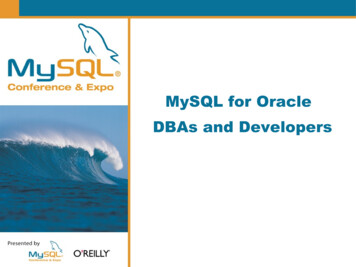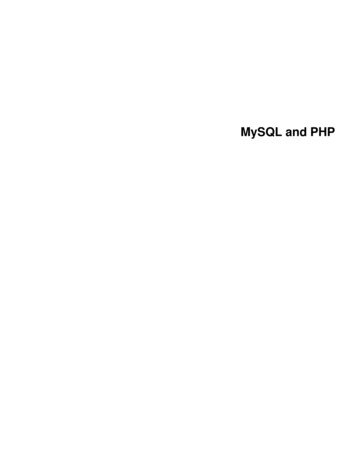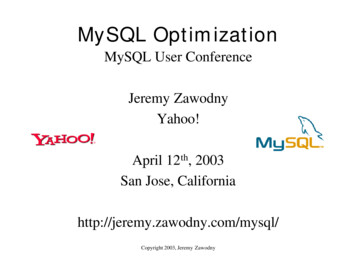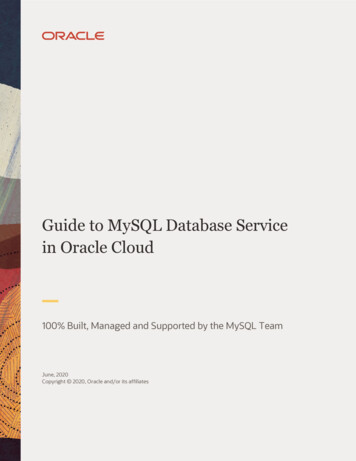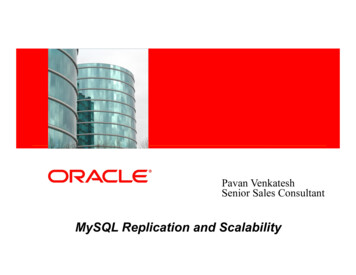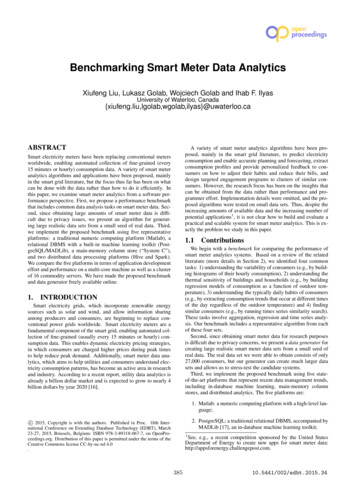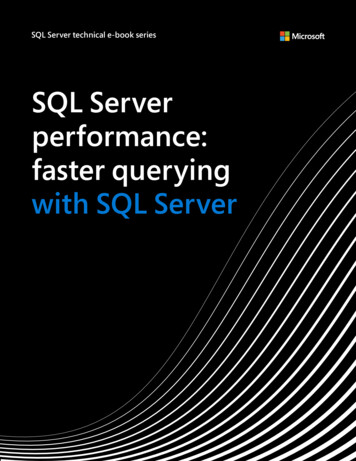
Transcription
Oracle Linux and MySQL TPC-C OptimizationsWhen Implementing the Sun Flash AcceleratorF80 PCIe CardORACLE WHITE PAPER OCTOBER 2014
Table of ContentsTable of ContentsiIntroduction2Optimizing Performance with the Sun Flash Accelerator F80 PCIe Card3Aligning the Sun Flash Accelerator F80 PCIe Card3Identifying the Appropriate Sun Flash Accelerator F80 PCIe Card3Identifying the Best RAID Level3File System Tuning4Tuning Oracle Linux5Invoke JEMALLOC6Invoke Huge Pages6Enable NUMA for the Sun Flash Accelerator F80 PCIe CardError! Bookmark notdefined.Linux Environment Variable Persistence for PCIe-based Devices after RebootsTuning MySQL810Conclusion11Resources11ORACLE LINUX AND MYSQL TPC-C OPTIMIZATIONS WHEN IMPLEMENTING THE SUN FLASH ACCELERATOR F80 PCIE CARD
IntroductionThe Sun Flash Accelerator F80 PCIe Card can help increase the performance of a databaseapplication, such as MySQL on an Oracle Linux platform. Once the Sun Flash Accelerator F80 PCIeCard has been installed, the most logical next question would be: “How do I set up the infrastructure inorder to get the best performance?” As each organization and environment is unique, no cookie cutterquestions will reveal specifically how the Sun Flash Accelerator F80 PCIe Card should be configuredfor optimum performance, but there are tools available and best practices to assist with this effort.Oracle Linux with Unbreakable Enterprise Kernel (UEK) was chosen for this study because of itsupstream support for the latest hardware relevant to modern data center operations. In addition,MySQL database workloads benefit from the platform’s deep integration with the solution stack,optimizations resulting from industry collaborations and enhancements in the UEK.Oracle Linux with UEK includes extensive performance and scalability improvements to the processscheduler, memory management, file systems, and the networking stack. It was tuned to performbetter and faster on leading-edge x86 configurations that feature many CPU cores and large amountsof main memory, and optimized libraries and system calls help to improve performance for MySQLqueries. Because of these optimizations and pervasive testing that occurs within Oracle, Oracle Linuxis able to address large transaction capacities and scale well as the number of database users or thenumber of databases increases.This document will present tuning and processes that can be applied to increase TPC-C performancewhen using the Sun Flash Accelerator F80 PCIe Card. The performance optimizationrecommendations that this document will review includes the following:» Sun Flash Accelerator F80 PCIe Card configuration» Oracle Linux configuration» MySQL database configurationMany of these optimizations were centered on increasing concurrency, decreasing locks, and allowingmore physical IO to the Sun Flash Accelerator F80 PCIe Card. The Oracle MySQL 5.6 InnoDB storageengine was used for all the tests referenced below.ORACLE LINUX AND MYSQL TPC-C OPTIMIZATIONS WHEN IMPLEMENTING THE SUN FLASH ACCELERATOR F80 PCIE CARD
Optimizing Performance with the Sun Flash Accelerator F80 PCIe CardAligning the Sun Flash Accelerator F80 PCIe CardThe most important step to perform on the Sun Flash Accelerator F80 PCIe Card is to create a partition that isaligned on a specific boundary (such as 4k or 8k) so each read and write to the flash device will require only onephysical input/output (IO) operation. If the Sun Flash Accelerator F80 PCIe Card is not partitioned on such aboundary, then reads and writes will span the sector groups which doubles the IO latency for each read or writerequest.To create an aligned partition, use the sfdisk command to start a partition on a 1M boundary (sector 2048).Aligning to a 1M boundary resolves the dependency to align to a 4k, 8k, and other boundaries divisible by 4k (forexample: 64k, 128k).Prior to this step, several questions should be posed about your specific deployment and how you are going to usethis device. Will this be a standalone partition, part of a logical volume, or part of a RAID group?Identifying the Appropriate Sun Flash Accelerator F80 PCIe CardTypically when deploying the Sun Flash Accelerator F80 PCIe Card for database caching (for example, using theOpen Source Flashcache developed by Facebook with MySQL), a single-partitioned Sun Flash Accelerator F80PCIe Card would be suitable if the capacity is sufficient to meet the needs of the database now and over the nextseveral years. In this case, the sfdisk command to create the partition would be:echo “2048,,” sfdisk –uS /dev/sdX --forceIf a need exists to deploy multiple Sun Flash Accelerator F80 PCIe Cards for database caching, create a LogicalVolume Manager (LVM) over all the Sun Flash Accelerator F80 PCIe Cards to simplify administration. The sfdiskcommand to create a partition for each Sun Flash Accelerator F80 PCIe Card is:echo “2048,,8e” sfdisk –uS /dev/sdX --force“8e” is the system partition type for creating a logical volume.Neither of these solutions requires fault tolerance since they will be used for write-thru caching, meaning data will betransparent between disk and cache.If the Sun Flash Accelerator F80 PCIe Card will be used for persisting data, then multiple Sun Flash Accelerator F80PCIe Cards will be needed to provide fault tolerance. By using two or more Sun Flash Accelerator F80 PCIe Cardsto build the RAID array, this concept will eliminate any single point of failure. There are a number of ways to create aRAID over multiple Sun Flash Accelerator F80 PCIe Cards, two of which are:» Use LVM with the RAID option.» Use the software RAID utility MDADM to create the RAID array.Identifying the Best RAID LevelOracle coined the term S.A.M.E., which means Stripe And Mirror Everything, in 1999 and popularized the practicethat many database administrators (DBA) and storage administrators continue to follow.To implement S.A.M.E., first determine how the Sun Flash Accelerator F80 PCIe Cards will be accessed. This couldinclude:» Small random reads and writes» Larger sequential reads3ORACLE LINUX AND MYSQL TPC-C OPTIMIZATIONS WHEN IMPLEMENTING THE SUN FLASH ACCELERATOR F80 PCIE CARD
» Hybrid (mix of both)In database deployments, your choice is usually among online transaction processing (OLTP) applications such asairline and hotel reservation systems, corporate financial or enterprise resource planning (ERP) applications, or ananalytical/data warehouse/data mining applications (DW), or a mix of these environments. OLTP applicationsinvolve small random reads and writes as well as many sequential writes for log files. Datawarehouse/analytical/data mining applications involve mostly large sequential reads with very few sequential logwrites.Before setting up one or many Sun Flash Accelerator F80 PCIe Cards in a RAID array, either using LVM on RAID orcreating a RAID array using multiple device administration (mdadm), it is important to understand the access patternof the IO, capacity requirements and budget. These requirements will dictate which RAID level will work best for thespecific environment.RAID options would include either a RAID 1/RAID 10 configuration (mirroring without striping, or striping andmirroring respectively), or RAID 5 (striping with parity). RAID 1/RAID 10 is a larger investment, but delivers the bestperformance, whereas RAID 5 costs less but imposes a significant write penalty. To optimize performance of anOLTP application, it is recommended to either implement a RAID 1 or RAID 10 array. If budget is a constraint, thenRAID 5 should be considered. In a Data Warehouse/Analytics environment where the majority of the IO is reads,RAID 5 would be the option to implement. Knowing how to tune the configuration to the application is a key toreaping the best performance.For either RAID array, create an aligned partition using sfdisk:echo “2048,,fd” sfdisk –uS /dev/sdX --force“fd” is the system identifier for a Linux RAID auto device.Keep in mind that it is not manda
Open Source Flashcache developed by Facebook with MySQL), a single-partitioned Sun Flash Accelerator F80 PCIe Card would be suitable if the capacity is sufficient to meet the needs of the database now and over the next several years. In this case, the sfdiskcommand to create the partition would be: echo "2048,," sfdisk -uS /dev/sdX --force

